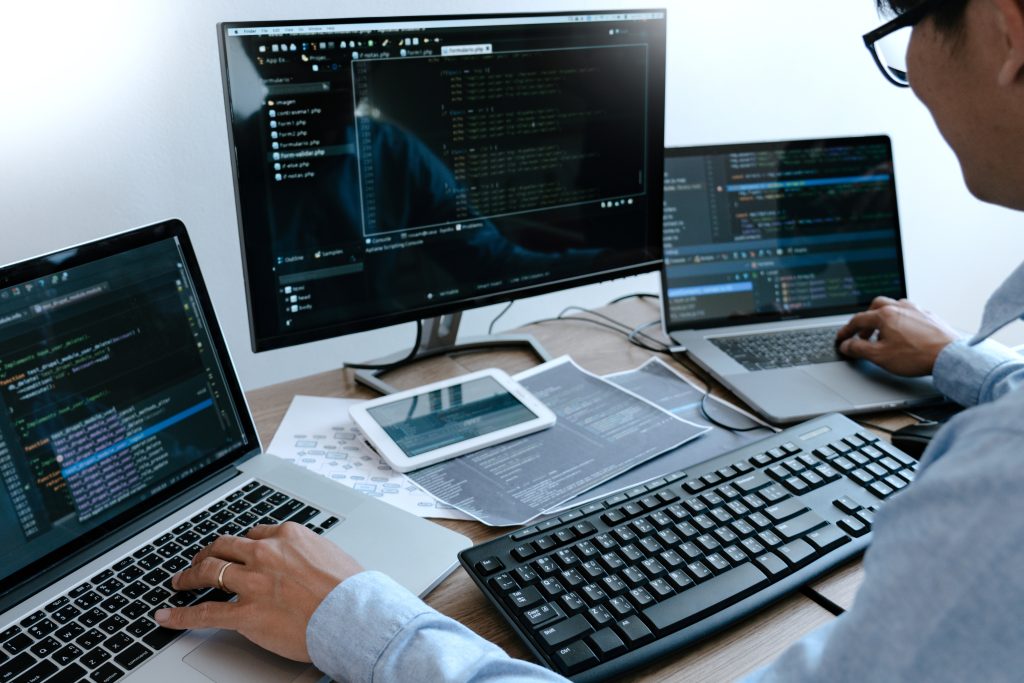Laptop Vs. Desktop: Which Is The Better Choice?
10 min read
When it comes to choosing between a laptop and a desktop, it can be a difficult decision to make. Both options have their pros and cons, and it’s important to consider your specific needs and preferences before making a final choice. In this comprehensive review, we will delve into the various factors that can help you determine which option is the better choice for you.
In today’s digital age, technology plays a crucial role in our daily lives. Whether it’s for work, entertainment, or communication, having a reliable and efficient computer is essential. However, with so many options available in the market, it can be overwhelming to find the perfect device that suits your needs.
The debate between laptops and desktops has been ongoing for years, with passionate advocates on both sides. Each option offers distinct advantages and disadvantages, making it crucial to assess your specific requirements and priorities. By considering factors such as portability, performance, customization, and budget, you can make an informed decision on whether a laptop or a desktop is the better choice for you.
The Competing Options: Laptop vs. Desktop
When it comes to choosing between a laptop and a desktop, there are a variety of factors to consider. Each option offers its own set of benefits and drawbacks, making the decision a matter of personal preference and specific needs. From portability to performance, cost to customization, the debate between laptops and desktops has been an ongoing one.

Differentiating Factors to Consider
When comparing products or services, it’s essential to consider several key differentiating factors to make an informed decision.
- Price: The cost of the product or service should be a major consideration, as it must align with your budget and financial capabilities.
- Quality: The overall quality of the product or service is crucial to assess, as it directly impacts its performance, durability, and overall value.
- Features: Products or services may differ in terms of the features they offer, such as functionality, versatility, and customization options, so it’s important to evaluate which features are most important to you.
- Customer Service: The level of customer service provided by the company can greatly impact your experience, from the purchasing process to after-sales support, so it’s crucial to consider.
- Accessibility: Consider the accessibility of the product or service, including factors such as availability, location, and ease of use, to ensure it meets your needs and preferences.
By thoroughly evaluating these differentiating factors, you can make a well-informed decision when comparing products or services.
Pros and Cons of Laptops
Laptops have become an indispensable tool for both work and leisure, providing users with the flexibility and convenience to work from anywhere. However, while they offer countless benefits, there are also drawbacks that should be considered before making a purchase.
Portability
Portability is a key benefit of laptops, allowing users to work or game on the go. The ability to easily transport a laptop from one location to another makes it ideal for students, professionals, and people with on-the-go lifestyles. In addition to this, battery life is essential for portability, as it determines how long a laptop can be used without needing to be plugged in.
Longer battery life means users can work or play for extended periods without interruption, further enhancing the portability of the device. The impact on productivity is also significant, as users can continue their tasks or entertainment without being tied down to one location.
When considering the purchase of a laptop, it is important to research the battery lifespan of different models. This aspect varies greatly between laptops, and understanding the battery life of a potential purchase is crucial for making an informed decision. To ensure the best portability and productivity, it is essential to find a laptop with a battery that suits your needs and lifestyle.
Real Estate & Storage Capacity
The correlation between real estate and storage capacity in desktops and laptops is evident in the default storage options and potential for upgrades. Desktops typically have more real estate for multiple hard drives, offering the advantage of increased storage capacity through the addition of extra drives. This allows for better organization of files and quicker access to data. In contrast, the real estate constraints of laptops limit storage expansion, often with only one hard drive and limited to no upgrade options.
The cost differences between upgrading storage in desktops versus laptops are significant. Upgrading storage in a desktop is generally more cost-effective, as it allows for the installation of additional hard drives at a lower cost per gigabyte compared to upgrading the storage in a laptop, which may involve replacing the existing drive with a larger, more expensive one.
Overall, the correlation between real estate and storage capacity in desktops and laptops showcases the advantages of having multiple hard drives in a desktop for greater storage capacity and organization, and the limitations of laptops in terms of storage expansion.
Mobility & Power Outages
To prepare for power outages, especially for individuals who rely on mobility aids, it is important to ensure that these devices are fully charged and easily accessible. This includes electric wheelchairs, scooters, or any other device that requires power. Regularly check the battery levels and charge them as needed to avoid being caught off guard during a power outage.
In addition to keeping mobility aids charged, it’s also a good idea to have backup power options available. This can include portable battery packs or generators specifically designed for powering mobility devices. These can provide temporary power during an outage until normal electricity is restored.
It’s also important to create an emergency plan that includes alternate methods of transportation in case of power outages. This may involve arranging for accessible transportation services or having a plan in place for how to safely navigate with mobility aids in the event of extended power loss.
By taking these steps to prepare for power outages, those who rely on mobility aids can ensure that they have the necessary power and transportation options during unexpected disruptions.
Cost & Performance
Desktop computers generally have a better cost-to-performance ratio compared to laptops. They offer higher performance for the price, particularly when it comes to processing power, graphics capabilities, and upgradability. This makes them ideal for resource-intensive tasks such as gaming, video editing, and 3D rendering. On the other hand, laptops are more expensive for the same level of performance due to their smaller and more portable form factor. However, laptops offer the advantage of mobility and are sufficient for everyday computing tasks.
The cost-to-performance ratio is affected by the form factor, with desktops providing better value for performance. Key factors that contribute to overall performance include internal specifications such as the processor, graphics card, RAM, and storage speed. Desktops have a superior edge in these areas due to their larger size and ability to accommodate more powerful components. Overall, desktops are the better choice for demanding tasks, while laptops offer convenience and mobility at a premium price.
Connectivity and USB Ports
USB ports and video ports are essential for both desktop and laptop computers, as they are crucial for connectivity and expanding the functionality of the devices.
For USB ports, there are several types including USB-A, USB-B, and the newer USB-C. These ports are used for connecting peripherals such as keyboards, mice, external storage devices, and smartphones. The difference between USB 2.0 and USB 3.0 lies in their data transfer speeds, with USB 3.0 offering significantly faster transfer rates. This can impact the user’s ability to transfer files and use peripherals effectively.
Video ports, such as HDMI, DisplayPort, and VGA, are necessary for connecting displays and external monitors to computers. Not having the right video ports can limit the user’s ability to connect multiple displays or use high-resolution monitors.
The number and type of ports available on a computer can impact the user’s ability to connect peripherals and external devices. Having an adequate number and variety of ports ensures that users can connect all necessary devices and expand the functionality of their computers. Therefore, it is important for both desktop and laptop computers to have a sufficient number and variety of USB and video ports to meet the user’s connectivity needs.
Graphics Card Capabilities & Screen Size
Laptops and desktops both offer a range of graphics card capabilities to enhance visual performance. For gaming, a dedicated graphics card is essential to handle the demands of high-resolution games. Laptops typically offer screen sizes ranging from 13 to 17 inches, providing a portable option with varying display sizes. Desktops, on the other hand, offer larger standard monitor sizes, typically ranging from 22 to 27 inches, which can provide a more immersive gaming or multimedia experience.
The graphics card in both laptops and desktops can greatly impact visual quality and performance, making it an important consideration for those looking to use their device for gaming or graphic-intensive tasks. The screen size options also play a crucial role in the overall user experience, with laptops offering portability and varying display sizes, while desktops offer larger, more stationary monitor options.
Expansion Options & Built-in Keyboard
Desktops offer more expansion options compared to laptops. They have more space for additional components such as graphics cards, additional storage drives, and extra memory. Some desktop models even have multiple bays for additional hard drives and SSDs. The built-in keyboard for desktops is usually a standard full-sized keyboard with a numeric keypad, offering a comfortable typing experience.
Laptops, on the other hand, have limited expansion options. Most laptops come with fixed components, and the only upgradeable parts are usually the memory and storage drive. The built-in keyboard for laptops is a compact version, lacking a numeric keypad. Despite this, some high-end laptops may offer backlit keyboards with customizable lighting.
Adding more storage to a desktop is relatively easy as they have more physical space for additional drives, making it as simple as plugging in a new drive and initializing it. Adding storage to a laptop, however, can be complicated. Many laptops have limited space for additional drives, and some may require opening up the entire device, posing a challenge for the average user.
Desktops typically come with a separate mouse and keyboard, while laptops come with a built-in touchpad and keyboard. Additional peripherals such as external monitors, webcams, and speakers are commonly used with desktops, whereas laptops are designed to be more portable and usually come with built-in webcams and speakers.

Pros and Cons of Desktops
Desktop computers have been a staple in the world of technology for decades, offering a reliable and powerful solution for both personal and professional use.
Price Tag & Value for Money
When evaluating the price tag and value for money of a product, it is essential to consider its features, durability, and overall quality. These aspects determine whether the cost of the product matches its benefits and usefulness.
In relation to the product’s features, durability, and quality, the price tag should reflect the level of performance and longevity it offers. A higher price may be justified if the product boasts advanced features, exceptional durability, and superior quality craftsmanship.
Additionally, a detailed analysis of the cost in comparison to its benefits and usefulness is important. Customers should weigh the price against the benefits and unique selling points to determine if it offers added value. This could include added features, warranty, or other advantages that set it apart from similar products on the market.
Ultimately, the price tag should align with the product’s overall quality, durability, and features, offering customers a good value for their money. This ensures that they are getting the most out of their investment while also considering any added value the product may provide.
Versatility in Setup Options & Expansion Options
Laptops are typically less customizable and have limited expansion capabilities compared to desktops. Desktops offer more flexibility for customization and upgrades. For desktops, setup options include various form factors and the ability to choose specific components such as CPU, GPU, and cooling systems. Expansion options can include adding more RAM, upgrading the graphics card, and increasing storage capacity.
In terms of storage expansion, both laptops and desktops can use external hard drives, but desktops have more internal upgrade options such as adding additional hard drives or SSDs. Adding additional monitors is simpler with desktops as they often have multiple video output options. Upgrading peripherals such as keyboards, mice, and audio systems can be easily done for both laptops and desktops.
To increase processing power, desktops have more options for upgrading the CPU, GPU, and cooling systems. Laptops may have some limited upgrade capabilities for the CPU and GPU, but it can be more complex and costly. Overall, desktops provide more versatile setup options and expansion capabilities, allowing for easier customization and upgrades compared to laptops.
Performance, Speed, RAM, Storage Space, Graphics Card
When evaluating the performance of a computer, it is important to consider several key factors. CPU speed, RAM, storage space, and graphics card all play a crucial role in determining the overall speed and performance of the computer.
The CPU speed determines how quickly the computer can process instructions, making it a critical factor in the overall speed of the system. A faster CPU speed means that the computer can handle more tasks simultaneously and execute them more quickly.
RAM, or random access memory, also has a significant impact on the performance of a computer. More RAM allows the computer to store and access more data quickly, improving the speed and responsiveness of the system.
Storage space is essential for storing files and applications. A larger storage space allows for more data to be stored locally, reducing the need to access external storage devices and improving overall performance.
The graphics card is crucial for tasks that require visual processing, such as gaming, video editing, and graphic design. A more powerful graphics card can handle more complex visual tasks, leading to a smoother and more responsive experience.

Conclusion
In conclusion, both laptops and desktop computers have their own unique advantages. Laptops are great for portability, allowing users to work on the go without sacrificing performance or convenience. Desktops offer more power and storage than laptops, making them a great choice for people who need a reliable machine for specialized tasks. Ultimately, the best choice between a laptop and desktop computer will depend on your needs and budget. By weighing all the factors carefully, you can make an informed decision that will help ensure your computer meets your needs and lasts for years to come.






